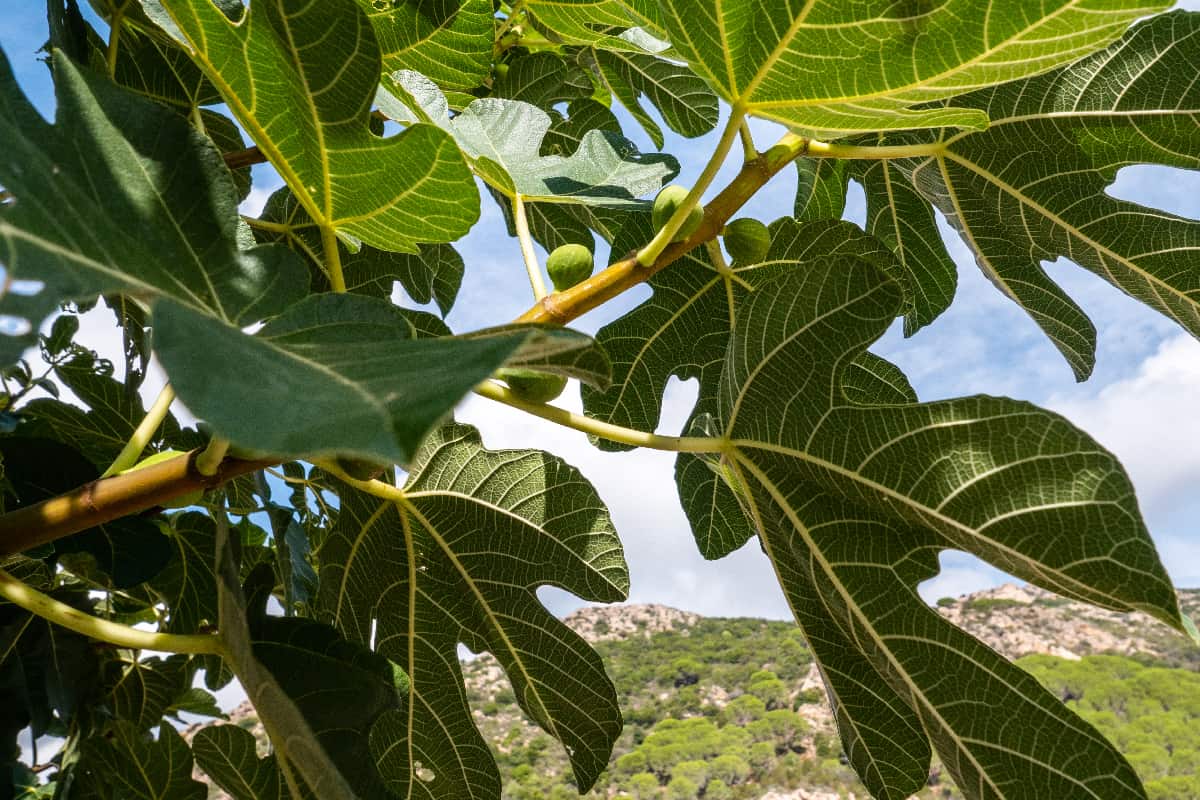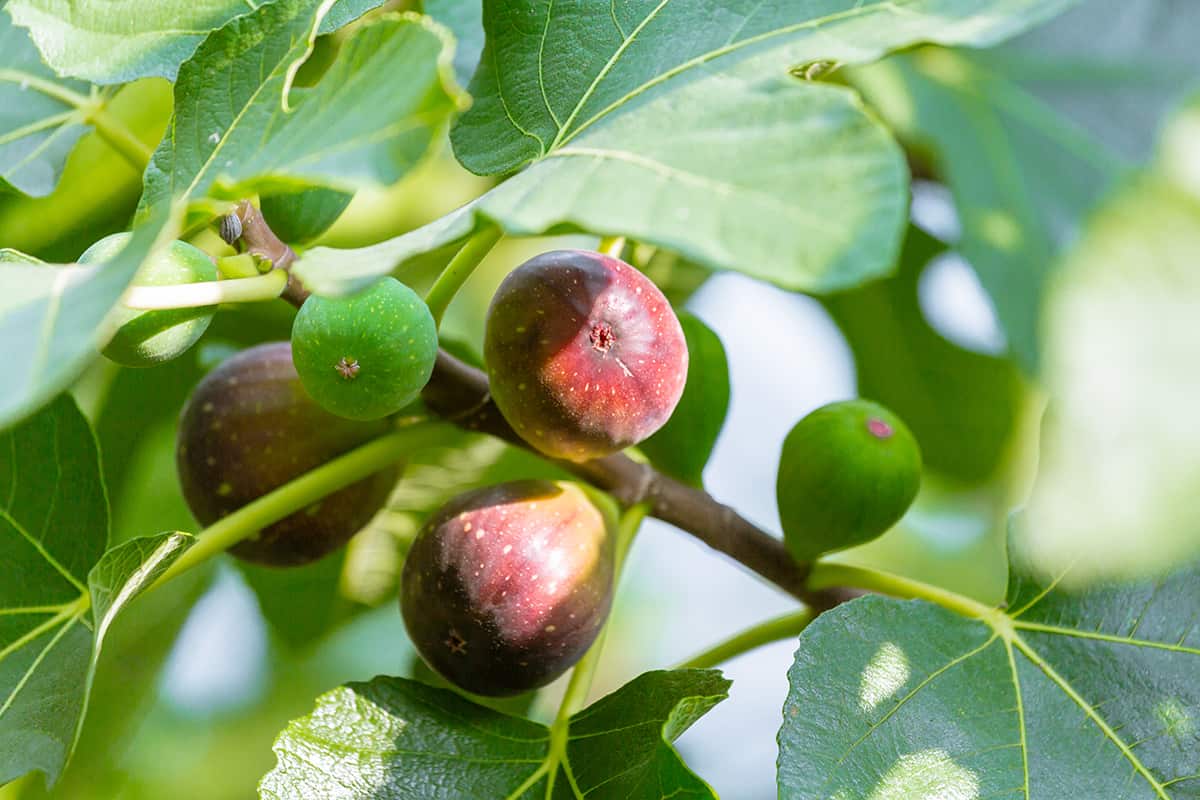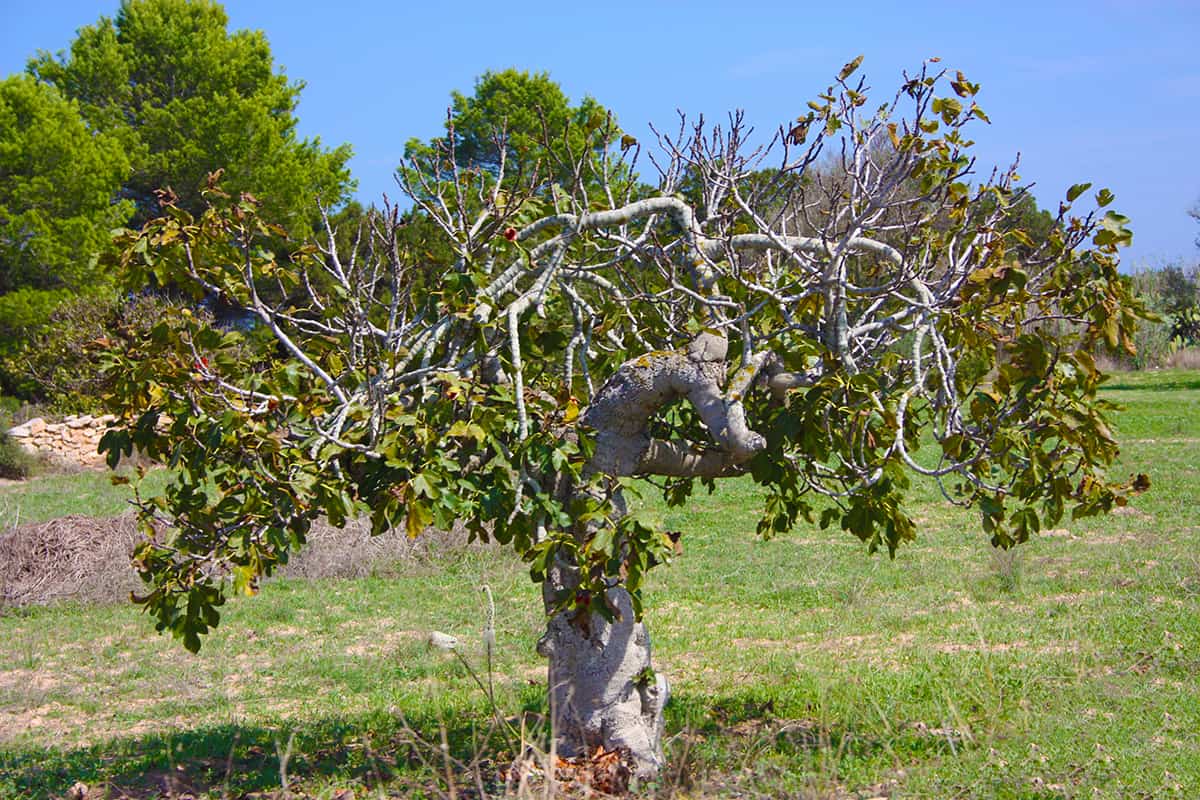![A two fig trees in a vast land field, Can You Grow A Fig Tree From A Fig? [Even A Dried Fig?]](https://gardentabs.com/wp-content/uploads/2022/08/Can-You-Grow-A-Fig-Tree-From-A-Fig-Even-A-Dried-Fig.png)
Although each variety has unique qualities, fig trees still share visible similarities. Their common attributes include their trunk, leaves, flowers, and fruits.
Trunk
It features crevices and holes on its surface, making the trunk a conducive nesting and dwelling site for tiny creatures such as ants, bees, lizards, and birds.
The green to yellow bark has a white latex-like gummy substance, which functions as a protective and self-healing mechanism.
Leaves

The lobed leaves of the fig trees are waxy. The period and span of leaf flushing differ for each species. However, their leaves are shed generally during dry seasons for the deciduous type.
Flowers
All variants produce tiny flowers within the stems. When the flower heads mature, they turn into syconia or false fruits.
Fruits

Fig trees bear bulb-shaped insect- and human-edible fruits throughout the year. Its fruits have tiny pores or ostioles at the pinnacle. You can easily enjoy the sweet and juicy fruits because of their thin skin and nutritional value.
The abundance of seeds when sliced varies based on the variant. They come in various colors depending on the variant: pink, red, and purple.
Roots
Most of the fig cultivars have invasive roots that can cause structural damage to your house or pavement. If you plant them under optimal conditions, root invasion will be less. You can also opt for pots or root barriers as a precaution.
- Identify the cultivar you prefer or purchase. The best fig type suits your location climate.
- Choose the propagation method: seed, wood cuttings, layering, or transplanting a sapling.
- Plant it while other trees are in dormancy or after the frost. Avoid sowing during fall.
- Next, if you prefer a potted fig tree, ensure the soil is new every three years and do not place it in direct sunlight. Meanwhile, allot at least a 20 feet of distance from walls for bare-rooted trees and keep them away from pipes.
- Finally, perform the primary care regularly for your plant: watering, fertilizing, pruning, and harvesting.
Watering
This low-care tree needs weekly irrigation. An extra layer of mulch is helpful for moisture retention.
Fertilizing
Even without additional fertilizer, figs thrive. Nonetheless, apply 1/2 pound of 10-30-10 or 10-10-10 NPK to your plant during spring if the soil has low fertility.
Otherwise, fertilize it once a year. The balanced fertilizer will nourish the soil immediately because of the quick-release nitrogen.
Click here to see this balanced fertilizer on Amazon.
Pruning
Schedule the pruning before winter because the cold temperature will reduce your yield in the next harvest period. Trim the fig tree while it is still young.
Prioritize the removal of dead branches and shoots near the ground. Remember to wear gloves when pruning to prevent skin irritation upon contact with its milky sap.
Harvesting
Usually, the fig has two seasons for fruit production after two to six years. The "breba" crop appears during the early summer. However, these fruits can be small because they germinated from the previous year. Afterward, the main produce ripens in spring.
While wearing gloves, handpick the figs gently without bruising them. Harvest the ripened ones in the early morning before the birds eat them. Avoid collecting the young crops because they will not mature.
Will Fig Cuttings Root In Water?
Growers successfully raise figs through stem cuttings in water. Hydroponics is an excellent alternative for fig propagation regardless of the season. Mixing a rooting hormone into your pot promotes root sprouts.
Do You Need Two Fig Trees To Get Fruit?

You do not need two fig trees to produce fruit. It is because seedless figs are parthenocarpic or self-fruiting. However, not all types can get fruit even without pollination or fertilization. Others have seeds.
Watch this clip if you want to grow a fig tree from its fruit.
Are There Male And Female Fig Trees?

Experts classify figs into two: monoecious and gynodioecious. The monoecious has male and female reproductive parts in different flowers, while the latter is a hermaphrodite in a single flower.
To tell if a fig tree is male or female, check its crop.
Female trees with short-style flowers contain seeds, requiring pollinators. They concentrate on seed production on rainy days. In contrast, the male figs possess long-style blossoms and focus on edible seedless fruit production after the wet months.
Monoecious Figs
Here are a handful of fig variants with perfect or bisexual flowering.
- Chinese banyan (Ficus microcarpa)
- Fiddle-leaved (Ficus lyrata)
- Indian banyan (Ficus benghalensis)
- Indian rubber (Ficus elastica)
- Moreton bay (Ficus macrophylla)
- Sacred (Ficus religiosa)
- Sycamore (Ficus sycomorus)
- Weeping (Ficus benjamina)
Gynodioecious Figs
Below are the figs with a mixed breeding system.
- Common (Ficus carica)
- Creeping (Ficus pumila )
- Lofty or clown (Ficus aspera)
- Mistletoe (Ficus deltoidea)
- Palm-leaf (Ficus pseudopalma)
- Roxburgh (Ficus auriculata)
Why Do Figs Have Wasps In Them?
The farmers in fig orchards introduce wasps, specifically the Pegoscapus. There are particular wasp species for every fig type. The female flowers release an attractive aroma to welcome the female wasps.
Upon entering, they will lose their wings and lay eggs, helping the seed to grow. When the grubs emerge, the male wasps will then appear and mate with female ones. Females die after fulfilling their mission.
This mutualism becomes a cycle. As a result, these seeming pests inside the fruit are vital in pollination and reproduction. However, seedless ones like common figs develop without wasps.
What To Plant Under A Fig Tree?

Elevate your landscape by planting shrubs and herbs alongside the fig tree. Place them within a 50-feet radius to avoid any damage to the fig tree's shallow roots.
Apart from the visual and smell appeal, these companion plants will boost the fig tree's health and growth, whereas shade-loving greeneries will benefit from its canopy.
- Artichokes
- Beans
- Chamomile
- Comfrey
- Dill
- Elderberries
- Lettuce
- Lavender
- Lemongrass
- Marigold
- Mint
- Nasturtium
- Rosemary
- Rue
- Stinging nettles
- Strawberry
- Thyme
- Wildflowers (daisies, poppies, and lupine)
Avoid raising plants with invasive roots, such as rhododendron, beside your fig tree. Their destructive roots will cause problems.
What Are The Uses Of Figs?
Despite being low-maintenance, the fresh edible fruits from the common fig are delicate and have a short shelf life. The ideal storage for this fig variant is between 40 to 43 degrees Fahrenheit.
However, they will not last well over a month inside the fridge, except if they are frozen or dried. People dry and process these sweet syconia to preserve and improve their flavor through sulfur fumigation, electric drier, or traditional food dehydration.
Furthermore, according to the Agricultural Marketing Resource Center, the U.S. exported and imported millions of dollars' worth of figs from 2020 to 2021, whether fresh or dried.
Apart from the dried delicacy, they are also helpful in your home and businesses, whether for breeding or ornamental.
- Alternative medicine
- Baked goods
- Candle
- Concentrate
- Dooryard plant
- Jam
- Laxative
- Latex-based household detergents
- Lubricant
- Moisturizer
- Seed oil
- Soap
- Perfume ingredient
Final Thoughts
Fig seeds are handy in growing fig trees. The seeds take time to perform compared to other methods. Giving them their essential requirements will help your fig tree thrive, regardless of its species.
Thanks for reading! If you enjoyed this post, explore these related articles on fig trees:
How To Tell If A Fig Tree Is Dead


